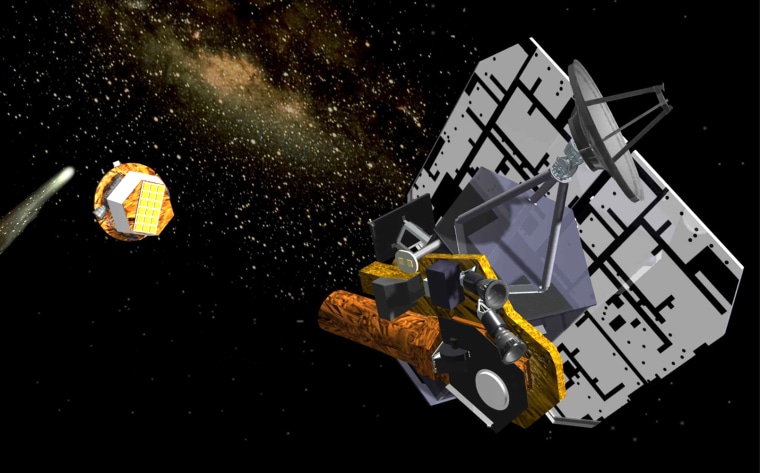Astronomers plan to slam an armchair-sized “impactor” into comet Tempel 1 to see what’s inside — and possibly help future scientists determine how to keep such space rocks from colliding with Earth.
If all goes as scheduled, the NASA Deep Impact spacecraft, set for launch on Dec. 30, will gently let go of the 820-pound (370-kilogram) impactor on July 4, 2005, and the comet’s rocky part will hit it at a speed of 23,800 miles an hour (10.2 kilometers a second).
The smash will take place 80 million miles (130 million kilometers) from Earth. While the comet itself is 100 times too dim to be seen with unaided eyes, the material thrown up by the collision could be visible with small telescopes, the project’s principal investigator said Thursday.
“We’re going to hit it and see what happens,” astronomer Michael A’Hearn of the University of Maryland said at a briefing outside Washington.
Laying bare a comet's heart
NASA’s Stardust spacecraft took pictures of the nucleus of comet Wild 2 during a fly-by last January, but Deep Impact will actually blast a crater into the heart of a comet to see its interior.

Knowing what is inside Tempel 1 could assist in later missions aimed at nudging a so-called doomsday space rock away from Earth. Such an impact could cause catastrophic damage, and scientists have been working to identify potentially threatening asteroids and comets, known as near-Earth objects, that might have the potential to collide with our planet.
Tempel 1 does not threaten Earth, but its inner workings could offer information about more menacing space rocks.
“The properties of the cometary nucleus (of Tempel 1) ... are probably representative of the really dark near-Earth objects, which are likely dormant comets,” A’Hearn said.
He said the Deep Impact mission, which will cost $311 million, will let future investigators know whether it would be easy to attach thrusters to a comet to push it out of the way.
How big a crater?
A’Hearn said the impact with Tempel 1 is likely to produce a crater the size of a football stadium on a comet with a diameter of about 3.7 miles (6 kilometers).
But if the comet’s nucleus is more like a solid ice cube, the impact might create a much smaller crater.
If the comet is made of what A’Hearn called solid pumice rock — hard but full of holes — the impact would simply compress the existing material.
Or the comet might even have the consistency of powdery snow, in which case the impactor would tunnel right through it.
A remote possibility is that the impact would create a shockwave that would break it apart, though A’Hearn called this the least likely scenario.
More information and images are available online.